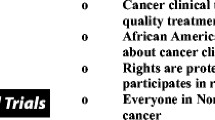Abstract
The process for advancing biomedical knowledge depends upon recruiting an adequate and representative sample of individuals to voluntarily participate in research studies. A consistent personal barrier to cancer clinical trial participation is the lack of awareness and understanding related to trial availability, and the prevention and treatment roles participation represents. In particular, comprehensive community-based approaches to recruit and educate rural residents are needed. Moreover, consistent under representation of priority populations should be addressed with innovative outreach to collaborate in identifying culturally meaningful approaches. A theoretically adapted version of a component of the National Cancer Institute's "Clinical Trial Education Series" was assessed via educational sessions delivered through work sites and churches. From eight focus groups with 90 participants, we found that church leaders, congregants, and community members were receptive to education on cancer research, increased their short-term knowledge about it, and intent to participate in cancer studies, decreased their current anxiety about clinical trials participation, and provided specific suggestions for further adapting the educational session to be even more culturally relevant. These outcomes provide evidence to support the effectiveness of future customized recruitment strategies embedded within a community or faith-based environment that may increase knowledge, decrease anxiety and intent to actual participation in cancer studies, as well as impact study representativeness and address causes of health disparities.

Similar content being viewed by others
References
EDICT (2008) Major deficiencies in the design and funding of clinical trials: a report to the nation improving on how human studies are conducted. Houston, TX.: Baylor College of Medicine
Comis RL, Miller JD, Aldige CR, Krebs L, Stoval E (2003) Public attitudes toward participation in cancer clinical trials. J Clin Oncol 21(5):830–835
Mills EJ, Seely D, Rachlis B et al (2006) Barriers to participation in clinical trials of cancer: a meta-analysis and systematic review of patient-reported factors. Lancet Oncol 7(2):141–148
National Cancer Institute (2009) Clinical trialCTs education series. http://www.cancer.gov/clinicaltrials/learning/clinical-trials-education-series Accessed 30 Jan 2009
Weiss EH, Golant M, Thornton A et al (2004) Open to options: a cancer clinical trials education pilot study. ASCO Meeting Abstracts 22(14 supplement):6116
Burhansstipanov L, Krebs LU, Bradley A et al (2003) Lessons learned while developing "Clinical Trials Education for Native Americans" curriculum. Cancer Control 10(5 Suppl):29–36
Knowles MS (1980) The modern practice of adult education: from pedagogy to andragogy, 2nd edn. Cambridge Books, New York
Merriam SB (2001) Andragogy and self-directed learning: pillars of adult learning theory. New Dir Adult Cont Educ 80:3–13
Grace AP (1996) Striking a critical pose: andragogy-missing links, missing values. Int J of Lifelong Educ 15(5):382–392
Coyne CA, Demian-Popescu C, Brown P (2004) Rural cancer patients' perspectives on clinical trials: a qualitative study. J Cancer Educ 19(3):165–169
Paskett ED, Cooper MR, Stark N et al (2002) Clinical trial enrollment of rural patients with cancer. Cancer Pract 10(1):28–35
Swanson GM, Ward AJ (1995) Recruiting minorities into clinical trials toward a participant-friendly system. J Natl Cancer Inst 87(23):1747–1759
Coyne CA, Demian-Popescu C, Friend D (2006) Social and cultural factors influencing health in southern West Virginia: a qualitative study. Preventing Chronic Disease 3(4):A124
Clark JW, Dawson LE (1996) Personal religiousness and ethical judgments: an empirical analysis. J Bus Eth 15:359–370
Simpson MR, King MG (1999) “God brought all these churches together:” issues in developing religion–health partnerships in an Appalachian community. Public Health Nurs 16(1):41–49
Hunsucker S, Flannery J, Frank D (2000) Coping strategies of rural families of critically ill patients. J Am Acad Nurse Pract 12(4):123–127
MacAvoy S, Lippman DT (2001) Teaching culturally competent care: nursing students experience in rural Appalachia. J Transcult Nurs 12(3):221–227
Cohen LH, Fine BA, Pergament E (1998) An assessment of ethnocultural beliefs regarding the causes of birth defects and genetic disorders. J Genet Couns 7:15–29
Weil J (1991) Mothers' postcounseling beliefs about the causes of their children's genetic disorders. Am J Hum Genet 48:145–153
Hatch JW, Cunningham AC, Woods WW, Snipes FC (1986) The Fitness through Churches project: description of a community-based cardiovascular health promotion intervention. Hygie 5(3):9–12
Chatter LM, Levin JS, Ellison CG (1998) Public health and health education in faith communities. Health Education Behavior 25(6):689–699
DeHaven MJ, Hunter IB, Wilder L, Walton JW, Berry J (2004) Health programs in faith-based organizations: are they effective? Am J Public Heath 94(6):1030–1036
Kaplan SA, Calman NS, Golub M, Ruddock C, Billings J (2006) The role of faith-based weight intervention for black women: a case study of an initiative in the southwest Bronx. J Health Care Poor Underserved 17(2 Suppl):9–19
Campbell MK, Hudson MA, Resnicow K, Blakeney N, Paxton A, Baskin M (2007) Church-based health promotion interventions: evidence and lessons learned. Annual Review of Public Health 28(1):213–234
Hippolyte JM, Phillips-Caesar EG, Winston GJ, Charlson ME, Peterson JC (2013) Recruitment and retention techniques for developing faith-based research partnerships, New York City, 2009–2012. Prev Chronic Dis 10:120–142
Acknowledgements
The authors appreciate the collaborative efforts of the Appalachia Community Cancer Network (5 U01 CA 114622 and 5 U54 CA 153604), the Northern Appalachia Cancer Network, and the Community Sciences and Health Outcomes Core, Pennsylvania State Hershey Cancer Institute in identifying community sites and partners for this study.
Author information
Authors and Affiliations
Corresponding author
Rights and permissions
About this article
Cite this article
Aumiller, B.B., Parrott, R., Lengerich, E.J. et al. Responses to a Theoretically Adapted Clinical Trial Education Session: Faith-Based Sites Versus Rural Work Site Dissemination. J Canc Educ 28, 698–708 (2013). https://doi.org/10.1007/s13187-013-0517-6
Published:
Issue Date:
DOI: https://doi.org/10.1007/s13187-013-0517-6




